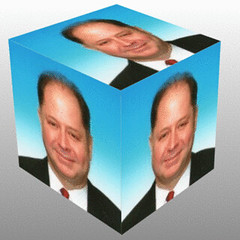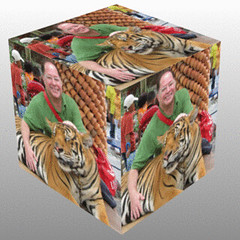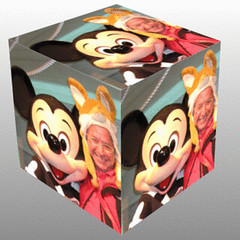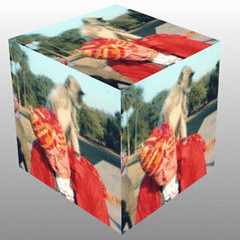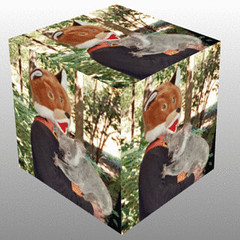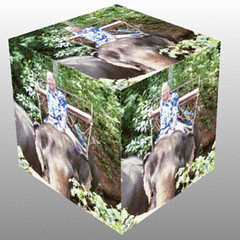Kyle XY and Clark Kent of Smallville have a lot in common. They are both teenagers. They both have superpowers. They are both on prime time television. Clark fights Luthor Corp. Kyle fights Madacorp. Both have fatherhood issues. Kyle is a clone of a super scientist Adam Baylin and Kyle has to hunt his father down. Clark’s dad is Jor El and is dead due to the destruction of Krypton and Clark deals with a holograph of his dad rather than a living dad. Both have “normal” human parents that teach them lessons in humanity. Both have female versions with their powers that are slightly more powerful. Kyle’s clone companion, Jessi XX, was created later and is a more advanced clone model and has super strength unlike Kyle. Supergirl, Clark’s cousin, can fly while Clark cannot.
I would say there is a strong chance that the creators of Kyle XY saw the success of Smallville and decided to make their own teenage superhero. Clark of Smallville is very different from Superman of the comic books and movies. Clark is young and much less experienced than Superman. An episode of Smallville starring the Legion of Superheroes, from the 31st century, lets us know that Clark will become Superman but the Legion in general finds Clark less than impressive compared to the legend of Superman. Clark is still discovering new superpowers during the first three or four episodes. Heat vision turns out to be especially problematic in one episode. As of episode eight Clark cannot fly with any regularity. Clark isn’t even really Superboy. The silver age comic book Superboy would demolish the Smallville Clark. Clark will probably skip the Superboy phase in this version of the Superman story. Clark hasn’t even put on a costume but this may happen in the upcoming ninth season.
I think one of the keys to the success of Smallville is that the creators have taken a lot of the plot line from the Marvel superhero Spiderman and interjected that plot line into the Superman mythos with great success. The early Spiderman could be summarized as “insecure teenager becomes superhero” and this is what Clark is doing. Superman is a DC character and Marvel is their competition. Imitation is the sincerest form of flattery.
One of the recurring plot line weaknesses of Superman is that Superman has been too powerful for interesting battles and/or adventures. Kryptonite was created by the Superman radio show in the thirties precisely to address this problem. In recent years Superman has been depowered and the current Superman is far less powerful than the silver age Superman.
The fans of comic books are largely male teenagers. Stan Lee, of Marvel comic books, figured out in the sixties that male teenagers might relate more to a hero that shared their insecurities like Spiderman. Marvel then really exploited the teenage superhero idea with the X-Men who are mostly teenagers and reside at the Xavier School for the Talented and Gifted rather than something like Superman’s Fortress of Solitude which is more a married with children man’s fantasy than a teenage guy fantasy.
Kyle XY premiered in 2006 and has a super brain. Kyle can detect mathematical patterns intuitively. In superpower speak this is some type of algorithmic pattern awareness. Kyle has photographic memory. Kyle excels at analyzing mathematical data but has high analytical skills in general and can excel in any scientific area. Overall, Kyle has super intelligence but due to not being raised by a family, but grown in a pod, lacked basic knowledge of human society and how people interact. The discrepancy between his analytical/mathematical intelligence and social knowledge was and is a major theme of the show.
Kyle can control his body and senses at superhuman levels. Kyle is like a super yogi. Kyle does not have a super body like Clark but due to his superior control of his nervous system can push his existing normal body to supernormal limits. This allows Kyle exceptional pain management. In particular, Kyle can increase his hearing but at a cost. Kyle becomes dizzy after pushing his body to superhuman levels and can even injure himself through over use of his super hearing.
Clark’s super hearing, on the other hand, does not involve any such price. Kyle also has photographic memory. Kyle’s photographic memory can tie directly into muscle memory and he can learn any kinesic skill upon watching someone perform this skill. If he watches a Bruce Lee movie then he will be able to perform any of the moves Bruce Lee demonstrated in that movie. In comic book circles this power is also referred to as photographic reflexes.
The Taskmaster is a major Marvel comic books super villain and only has this superpower and takes on the likes of Captain America. Kyle’s photographic reflexes are downplayed in his TV series and he has not gone the next logical step and mastered every martial art around to become some sort of super fighter. Instead Kyle tends to try to reason his way out of tough situations.
Kyle has something beyond photographic memory and this is called holographic memory. Kyle can search through his memories as though he was having the experience again. Kyle has super learning. Kyle learned how to talk in one day. Kyle has the mental equivalent of a firewall and can resist mind control. Kyle has limited telepathy. Kyle has limited telekinetic abilities that have two origins. The basis of his telekinetic abilities lie in his ability to change the polarity of his cells and attract or repel water. Kyle can also change the gravitational field around an object.
Kyle has an interesting way of drawing and basically draws like a dot matrix printer and makes a series of points, usually with crayons, that allow him to make pictures that resemble photographs in their clarity. This photographic drawing ability and photographic memory ability means he can make pictures of events and things he does not fully understand at the time and then figure out what is going on by looking at the picture and/or sharing the picture with others, generally his family, who can help him figure out the picture. Kyle is kind of the ultimate eye witness!
Kyle’s major weakness is his aforementioned lack of social experience and he can be easily manipulated by con artist types although his instincts about people are pretty good despite his lack of social experience and over time he is learning more and more about social interaction and norms. Kyle has all the physical weakness of any human. His super brain can overtax his all too human body. Kyle does not have a belly button due to being raised in a pod rather than a womb and his CAT scans show way too much activity but all in all Kyle is human and can pass for human more easily than Clark. Kyle can hide his superhuman nature via restraint. Clark is an alien and must avoid a physical examination at all costs to keep his powers secret.
Clark’s superpowers are much more well known than those of Kyle XY and are basically Superman’s but on a lower power scale and minus flight. Clark’s superpowers include invulnerability, super strength, super speed, heat ray vision, X-Ray vision, and super hearing, far beyond Kyle’s level and without the fatigue weakness. Clark is bright but does not appear to have super intelligence unlike many versions of Superman. Clark also cannot fly at this time.
Clark also has a strong sense of ethics that comes from being raised on a Kansas farm and generally knows what the right thing to do is and acts as a natural born leader to those around him including other superheroes, the Justice League, Green Arrow, the Legion of Superheroes, due to this strong sense of right and wrong. This is in contrast to Kyle who is still trying to figure out the subtleties of human morality and in particular the discrepancy between what humans say is moral and what they do.
Clark’s number one weakness is kryptonite. Green kryptonite can kill him. Red kryptonite turns him into a hedonistic psycho not necessarily a bad guy but more of a rebel without a cause on steroids. Green kryptonite is all over Smallville! The meteor showers that brought Clark to Smallville also apparently brought tons and tons of green kryptonite to Smallville. In just about all other versions of Superman, green kryptonite is super rare and bad guys go to the trouble of spending millions to synthesize the stuff because it is so rare. No need for a bad guy in the Smallville universe to spend a dime synthesizing kryptonite since the stuff apparently is just lying all over the place. This makes Clark relatively vulnerable compared to other versions of Superman. Still super speed and super senses mean that Clark can move faster than a speeding bullet including kryptonite bullets and hear the clicking of the chamber before the bullet is even fired.
Clark has fought Braniac, a super computer from his home planet Krypton. Braniac has super intelligence on a level that dwarfs Kyle. Clark’s number one enemy is Luthor, who in the Smallville version does not have super intelligence, unlike the Silver Age comic book version. The Smallville Luthor does have extreme cunning and access to the most advanced research labs in the world via Luthor Corp. Luthor does have access to the finest minds on Earth and knows how to manipulate people including scientists who may be smarter academically than Luthor but not as cunning as Luthor. A team of the finest minds with the best research capabilities on Earth might have a combined IQ that is greater and more dangerous than Kyle’s IQ. The contests between Luthor and Clark can be seen as contests between brain versus brawn to a great extent and Clark has always come out ahead.
Besides Luthor, Clark has gone up against a army of superpowered foes that are far more powerful than anything Kyle has gone up against so Clark has the experience edge. Green kryptonite can give humans superpowers and apparently every other teenager in Smallville has been exposed to green kryptonite and the green stuff also seems to make humans into psychos but this is debatable. So in a boring head on contest Clark would probably beat Kyle but the purpose of these posts is to entertain not bore!
The scenario, Luthor manipulates Kyle into thinking Clark is the vanguard of an alien invasion. This would be no problem for Luthor whatsoever since he has manipulated people far less naïve than Kyle. This event happens after season six when Luthor knows all of Clark’s secrets including his weakness to kryptonite and Kyle comes up with about a hundred fantastic weapon delivery systems to “stun” Clark with kryptonite despite Clark’s super speed and super senses. Luthor has lied to Kyle and told him that Kryptonite stuns rather than kills Kryptonians since Luthor realizes Kyle would never agree to kill anyone even an alien invader.
Kyle belatedly does an internet search about Luthor and realizes he has been had and that Luthor is a very, very bad person based on his business practices that are a matter of public record. Kyle then hacks into the files of Luthor Corp and realizes that Luthor is not just bad but evil! Kyle warns Clark of Luthor’s impending attack and together they attack Luthor Corp. Clark explains to Kyle that the best defense is a strong offense. Kyle attacks the computers of Luthor Corp. Clark attacks the muscle guarding the computers at Luthor Corp so Kyle can get to them. Clark is constantly breaking into Luthor Corp secret centers so this should be familiar territory for him. Even Madacorp has been firebombed by Kyle’s mentor. As stated, Clark has broken into Luthor Corp secret centers before even with Justice League members but never with someone like Kyle!
Kyle uses a terminal at the secret Luthor Corp lair to erase all data and I mean all data from all Luthor Corp’s computers including all financial data and Luthor is left with a company minus money and research data and Luthor Corp is all about data. Kyle doesn’t stop there and decides to leave Luthor Corp about a billion bucks in the red and exposes every crime, fraud and misplaced paper clip that Luthor corp was ever involved in to the Feds and the Daily Planet by emailing the pertinent records so Luthor ends up being chased by debt collectors and the law. Who knows which is worse?
Luthor Corp is destroyed but is Luthor? Luthor is cunning but not much without the resources of Luthor Corp or at least in the short range. Years later, Luthor is bankrupt and has served time in jail for fraud. Luthor even had to use all of his hidden cash in the Caymans, not on the Luthor Corp books, on lawyers and assasins to kill those who could have expose more serious crimes. His company, his money, his good name and his friends are all gone! Luthor is pan handling for booze on the streets of some third world hell hole where he is not recognized when he sees a picture of Kyle and Clark on the front page of the Daily Planet that some expat has thrown on the ground. It is of course raining! Rain drops and mud cover the newspaper but Luthor can still read the front page.
Apparently Clark and Kyle have started some sort of think tank charity to solve the problems of the world. Kyle comes up with the science while Clark does hero for hire jobs to pay for the research and implementation. Luthor raises his fists to the sky, throws the bottle of cheap local whisky he was drinking to the ground, breaking the bottle, and vows, “I will never be poor again”. “That which does not kill you only makes you stronger”, thinks Luthor. Of course the guy who originally wrote that died in an insane asylum. I like to say, “There are many things that will not kill you but can maim you for life in such a way that death would seem like a good thing”.
Luthor creates a new criminal organization that has a corporate structure but is more mafia than corporation and far deadlier and secretive than Luthor Corp ever was and the first thing on the agenda of this corporation is the destruction of Clark and Kyle. Luthor even manages to hire a lot of the more nefarious elements of Madacorp to work for his new organization. Thus a new series begins that combines the fan bases of both Kyle XY and Smallville and makes untold millions while I suffer the slings and arrows of middle class existence.
WereVerse Universe Baby!














